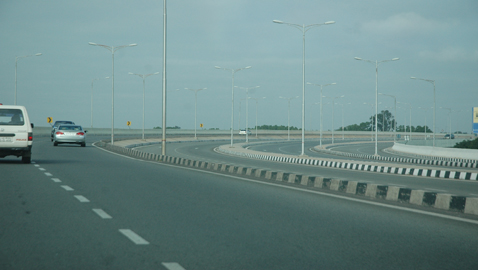
Despite the ambitious target set by the Ministry of Road Transport and Highways in 2009 to construct 20 km of national highways per day, the National Highways Authority of India could widen and upgrade only between 3.06 km and 17.81 km of roads during the period 2009-10 to 2012-13, according to a recent report by the Comptroller and Auditor General of India.
Based on a performance audit of NHAI to examine the implementation of 94 public-private partnership projects under phases II, III, IV & V of the National Highways Development Programme out of the 207 projects awarded in the PPP mode as on March 31, 2012, the report by the country’s supreme audit institution was laid on the table of Parliament House on December 23, 2014.
The report points out that NHAI had been inconsistent in adopting carrying capacity/tollable traffic as yardstick for determining the concession period, which in turn, led to fixing higher concession period and more burden on road users by way of toll for the extended period. The burden of additional toll on road users amounted to Rs. 28,095.54 crore (NPV Rs. 3,233.71 crore).
Several other flaws in the implementation of PPP highway projects have been brought out in the report. Change of scope in 23 projects cost NHAI Rs. 856.80 crore, out of which Rs. 662.53 crore was on account of deficient detailed project reports and feasibility reports. In six completed annuity projects, NHAI could not commence toll collection due to delay in achieving Commercial Operation Date. The delay resulted in loss of toll collection amounting to Rs. 259.47 crore. Further, toll of Rs. 171.37 crore could not be collected because of delay in issue of toll notification (Rs. 157.65 crore) and failure to commence toll collection after issue of toll notification (Rs. 13.72 crore) for these projects.
On four partially completed stretches, NHAI allowed toll collection placing an extra burden of Rs. 161.67 crore on road users. In three six-laning projects that had failed to achieve milestones, the concessionaires collected toll of Rs. 902.89 crore but the amount was not transferred to the ‘withheld amount account’. In case of two projects, NHAI approved four-laning even though the minimum threshold traffic was not expected to be achieved in the next five to 12 years. The extra construction cost as a result of the unwarranted four-laning amounted to Rs. 1,724.10 crore.
In 25 projects, the CAG found the total project cost worked out by the concessionaires was higher by 50 per cent than that of NHAI. The variance placed NHAI at risk in the event of termination. The performance audit by the CAG reveals NHAI had vitiated the process of competitive bidding for BOT-Toll projects which were initially found to be unviable but later restructured to ensure viability. In the case of such projects, fresh Request for Qualification was not invited in spite of major changes in the initial project parameters. The audit highlights that NHAI prematurely released Viability Gap Funding of Rs. 769.53 crore for four projects in contravention of the provisions of the Model Concession Agreement.
The CAG in its report also comments on the staff strength of NHAI and its dependence on officials on deputation from other government departments and consultants. In November 2009, the Department of Personnel and Training – Ministry of Personnel, Public Grievances and Pensions had directed that the structure of NHAI be reformed within two years to provide for its own independent cadre through direct recruitment and absorption of those on deputation. However, at the end of March 31, 2013, the ratio of personnel on deputation basis to regular employees in the NHAI stood at 83:17.











